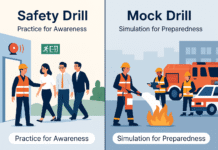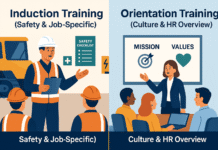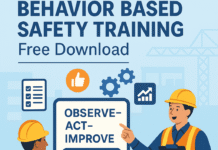
5 Minute Safety Topics
Safety is everybody’s business, but let’s face it—nobody likes long, boring lectures. That’s where 5 minute safety topics come in. These short, impactful talks keep workers engaged, promote safety awareness, and take almost no time out of your day.
What Are 5 Minute Safety Topics?
They’re also called Toolbox Talks or Safety Moments. These quick discussions are delivered at the start of a shift or before a task to highlight a specific safety concern. Think of them as your safety espresso shot—quick, powerful, and energizing.
Why Are They Important?
Because they keep safety top of mind. When you talk about hazards every day, you’re more likely to recognize and avoid them. It’s not just about compliance—it’s about culture.
Benefits of 5 Minute Safety Talks
1. Builds Safety Awareness
You can’t avoid what you don’t know. These talks help identify risks before they become accidents.
2. Reduces Workplace Incidents
When safety is discussed daily, habits form. Good ones. The kind that keep fingers, toes, and lives intact.
3. Encourages Communication
These talks create space for open conversations about safety. It’s not top-down—it’s team-wide.
4. Fits Into Busy Schedules
Time is money. These talks are short and sweet—perfect for a quick safety check before diving into the day’s work.
How to Conduct an Effective 5 Minute Safety Talk
1. Choose the Right Time and Place
Hold it before shifts, in break rooms, or near the jobsite. Wherever people gather naturally.
2. Keep It Simple and Focused
One topic. One message. That’s the golden rule. Don’t overload your team with too much info.
3. Use Real-Life Examples
Nothing grabs attention like a real accident story. Make it relatable.
4. Encourage Questions and Interaction
Let your team talk. Safety isn’t a monologue—it’s a dialogue.
15 Powerful 5 Minute Safety Topics
1. PPE (Personal Protective Equipment)
Slide Title: “PPE: Your First Line of Defense”
Key Message: PPE doesn’t make you invincible, but it gives you a fighting chance.
Talking Points:
- What is PPE? Examples: helmet, gloves, goggles, safety shoes, hearing protection.
- Why it’s required by law and company policy.
- Fit matters. Poorly fitting PPE is dangerous.
- Always inspect PPE before use—damaged equipment should be reported or replaced.
Real-Life Example:
“Last year, a worker in our industry suffered eye damage due to skipping goggles during a grinding task. A 5-second shortcut cost him his vision in one eye.”
Call-to-Action:
Before you start today’s work, check your PPE. Replace what’s damaged, and wear what’s required. Your safety starts with your gear.
2. Slips, Trips, and Falls
Slide Title: “Don’t Slip into Trouble”
Key Message: Most falls happen on the same level—right where you’re standing.
Talking Points:
- Wet floors, cluttered walkways, and uneven surfaces are top causes.
- Always report spills and clean as you go.
- Use proper lighting—dark areas are hazard zones.
- Wear non-slip footwear appropriate for the job.
Real-Life Example:
“A technician tripped over an extension cord left uncoiled and fractured his wrist. It delayed the project by 3 weeks and cost the company thousands.”
Call-to-Action:
Take 60 seconds to check your work area now—clear it, clean it, and avoid becoming the next statistic.
3. Fire Safety Basics
Slide Title: “Fighting Fires Before They Start”
Key Message: Prevention is better than suppression.
Talking Points:
- Know the location of extinguishers and exits.
- Don’t block fire equipment or escape routes.
- Use electrical equipment properly—don’t overload circuits.
- Never smoke in unauthorized areas.
Real-Life Example:
“At a nearby site, a fire broke out due to oily rags left near a heater. No injuries, but damage was estimated at $25,000.”
Call-to-Action:
Today, check if extinguishers are clear, exits are open, and nothing flammable is in the wrong place. If you see something, say something.
4. Lockout/Tagout (LOTO)
Slide Title: “One Mistake Can Be Fatal”
Key Message: Don’t assume equipment is off—prove it.
Talking Points:
- LOTO prevents accidental startup of machinery.
- Only authorized personnel can perform lockout procedures.
- Never remove someone else’s tag.
- Verify that energy is fully released—don’t just press a switch.
Real-Life Example:
“A worker bypassed lockout on a jammed conveyor. It restarted during cleaning, crushing his hand. He never returned to work.”
Call-to-Action:
Before starting any maintenance today, ensure lockout/tagout is followed 100%. Your life is worth more than a shortcut.
5. Ladder Safety
Slide Title: “The Right Way Up”
Key Message: A 6-foot fall can be fatal. Don’t take chances.
Talking Points:
- Inspect ladders for cracks, missing steps, or loose bolts.
- Maintain three-point contact—two hands and one foot, or two feet and one hand.
- Never stand on the top rung.
- Set the ladder on a stable, level surface. Secure if needed.
Real-Life Example:
“An electrician rushed and climbed a ladder in the rain. The base slipped, and he fractured his spine. He’s still in rehab.”
Call-to-Action:
Check every ladder before using it today. If it’s damaged or unstable—tag it, report it, and don’t use it.
6. Electrical Safety
Slide Title: “Electricity: Silent but Deadly”
Key Message: You can’t see electricity—but it can kill in seconds.
Talking Points:
- Inspect cords, plugs, and equipment before use.
- Never use damaged wires or exposed outlets.
- Keep water away from electrical tools.
- Only qualified personnel should repair or modify electrical systems.
Real-Life Example:
“A worker using a power drill with a frayed cord got electrocuted. Luckily, the breaker tripped—but it could’ve ended in tragedy.”
Call-to-Action:
Today, inspect all electrical tools before you plug in. Report or replace damaged items immediately.
7. Safe Lifting Techniques
Slide Title: “Lift Smart, Not Hard”
Key Message: Protect your back—it doesn’t come with a warranty.
Talking Points:
- Bend at the knees, not the waist.
- Keep the load close to your body.
- Don’t twist while lifting—pivot with your feet.
- Ask for help with heavy or awkward items.
Real-Life Example:
“One of our team members ignored proper lifting form and suffered a herniated disc. Months of therapy followed.”
Call-to-Action:
Before lifting anything today, assess the weight. If it’s too much, get help or use mechanical assistance.
8. Working at Height
Slide Title: “One Slip = No Second Chance”
Key Message: The higher you go, the harder you fall.
Talking Points:
- Always wear a full-body harness with lanyard or fall arrest.
- Anchor points must be secure and rated.
- Inspect harnesses and lanyards before every use.
- Never work at height alone.
Real-Life Example:
“A scaffolder fell from 12 feet due to a broken lanyard. His harness saved him—but only because he inspected it first.”
Call-to-Action:
Check your harness and anchor point now. A 2-minute inspection could save your life.
9. Hazard Communication (HAZCOM)
Slide Title: “Know What You’re Working With”
Key Message: Labels and SDSs aren’t just paperwork—they’re lifesavers.
Talking Points:
- Always check the label before using any chemical.
- SDS (Safety Data Sheet) provides hazard info, handling instructions, and PPE needed.
- Never mix chemicals unless trained.
- Store chemicals properly and securely.
Real-Life Example:
“A cleaning crew unknowingly mixed bleach with acid—it created toxic gas. Three people were hospitalized.”
Call-to-Action:
Before using any substance today, check the label and SDS. Know the risks before you open the lid.
10. Heat Stress and Hydration
Slide Title: “Beat the Heat, Stay on Your Feet”
Key Message: Dehydration can sneak up and knock you down.
Talking Points:
- Drink water every 20 minutes—don’t wait until you’re thirsty.
- Wear light, breathable clothing and rest in shaded areas.
- Know signs of heat exhaustion: headache, dizziness, nausea.
- Heatstroke is a medical emergency—act fast.
Real-Life Example:
“A pipe fitter ignored early signs of heat stress. He collapsed and was unconscious for 15 minutes—ambulance had to be called.”
Call-to-Action:
Hydrate often, take breaks, and speak up if you or a coworker feels off.
11. Cold Stress and Hypothermia
Slide Title: “Stay Warm, Stay Safe”
Key Message: Cold weather doesn’t just make you uncomfortable—it can kill.
Talking Points:
- Dress in layers: base, insulation, and waterproof outerwear.
- Keep hands, feet, and head covered.
- Take warm-up breaks often.
- Watch for frostbite (numb, white skin) and hypothermia (shivering, confusion).
Real-Life Example:
“A technician working outside in freezing rain didn’t wear gloves. He suffered frostbite and lost two fingertips.”
Call-to-Action:
Layer up before heading outside. Today’s discomfort can turn into tomorrow’s injury.
12. Eye Safety
Slide Title: “Protect Your Vision—It’s Irreplaceable”
Key Message: A second of neglect can cost a lifetime of sight.
Talking Points:
- Always wear safety goggles or face shields during grinding, welding, cutting, or chemical use.
- Replace scratched or fogged lenses.
- Keep eyewash stations accessible and clean.
Real-Life Example:
“A mechanic sprayed solvent without goggles. It splashed back and caused permanent damage to one eye.”
Call-to-Action:
Check your eye protection today. Don’t work blind—protect your sight.
13. Housekeeping in the Workplace
Slide Title: “A Clean Site is a Safe Site”
Key Message: Clutter leads to chaos—and accidents.
Talking Points:
- Keep walkways and exits clear.
- Return tools to proper places after use.
- Clean spills immediately.
- Dispose of trash and scrap properly.
Real-Life Example:
“Someone left oily rags near a welding area. A fire broke out and could have destroyed the whole workshop.”
Call-to-Action:
Take a few minutes now to tidy your area. A cleaner workplace is a safer workplace.
14. Emergency Evacuation Procedures
Slide Title: “When Seconds Matter, Be Ready”
Key Message: You don’t rise to the occasion—you fall to your training.
Talking Points:
- Know your evacuation route and muster point.
- Don’t delay—leave immediately when alarm sounds.
- Help others, but don’t go back for belongings.
- Know who to report to once evacuated.
Real-Life Example:
“In a recent drill, several people froze or panicked. If it had been real, lives could’ve been lost.”
Call-to-Action:
Look around. Identify the nearest exit now. In an emergency, that knowledge is your lifeline.
15. Mental Health and Workplace Stress
Slide Title: “You Matter—Inside and Out”
Key Message: Mental health is just as important as physical safety.
Talking Points:
- Stress, anxiety, and burnout affect concentration and increase risk of accidents.
- Talk to someone—a manager, a colleague, or a counselor.
- Encourage a supportive environment.
- Watch for signs in coworkers—withdrawal, irritability, fatigue.
Real-Life Example:
“A technician under heavy stress made a critical error while operating machinery. It resulted in a near-miss that could’ve killed a coworker.”
Call-to-Action:
Check in with yourself today. And check in with a teammate too. Support saves lives.
Tips to Keep Safety Talks Engaging
1. Start with a Story
Begin with a real-life incident. It creates emotional impact and gets everyone’s attention.
2. Use Props or Demonstrations
Show how a harness works. Hold up a damaged glove. Visuals stick.
3. Involve the Team
Ask questions. Get feedback. Let someone else lead occasionally.
Conclusion
5 minute safety talks aren’t just “nice to have”—they’re critical. They’re the heartbeat of a proactive safety culture. Quick, simple, and powerful, they keep teams informed and alert. So the next time you think you don’t have time for a safety talk—remember, you don’t have time not to.
Types of Safety Training for Employees
Safety Induction Training for Employees
50 Workplace Safety Topics for Meetings
How to Conduct a Safety Induction for New Workers (With Script)
FAQs
1. What are the key elements of a good safety talk?
A focused topic, relatable examples, team interaction, and a clear takeaway.
2. How often should safety talks be held?
Ideally, daily or at least once a week depending on the work environment.
3. Can 5 minute safety talks really make a difference?
Absolutely. They keep safety fresh and top-of-mind, which can significantly reduce incidents.
4. Who should deliver safety talks?
Supervisors, safety officers, or even team members. Rotate for better engagement.
5. Where can I find ready-to-use safety topics?
You can create your own, use your company’s safety manual, or find resources online like OSHA, NEBOSH, or HSEStudyGuide.com.
























